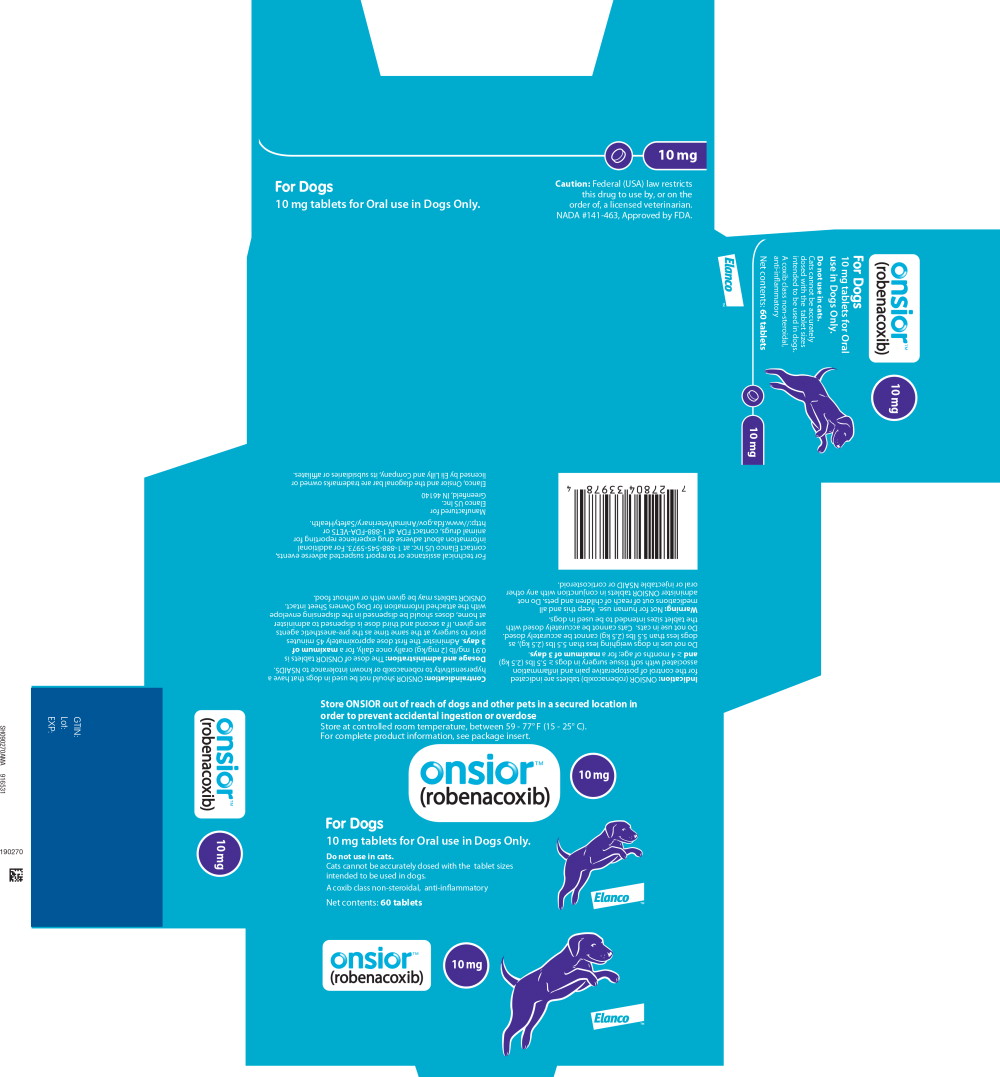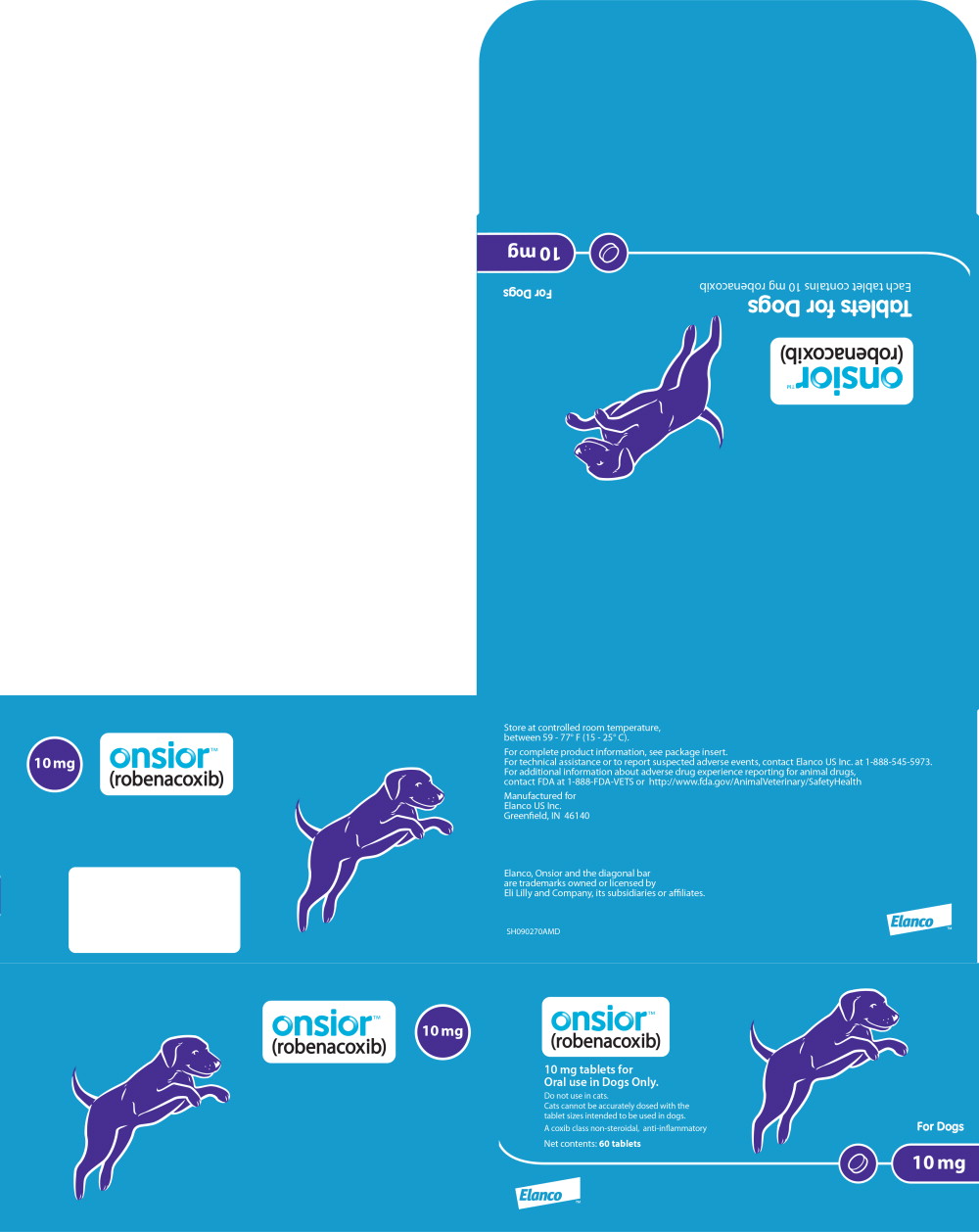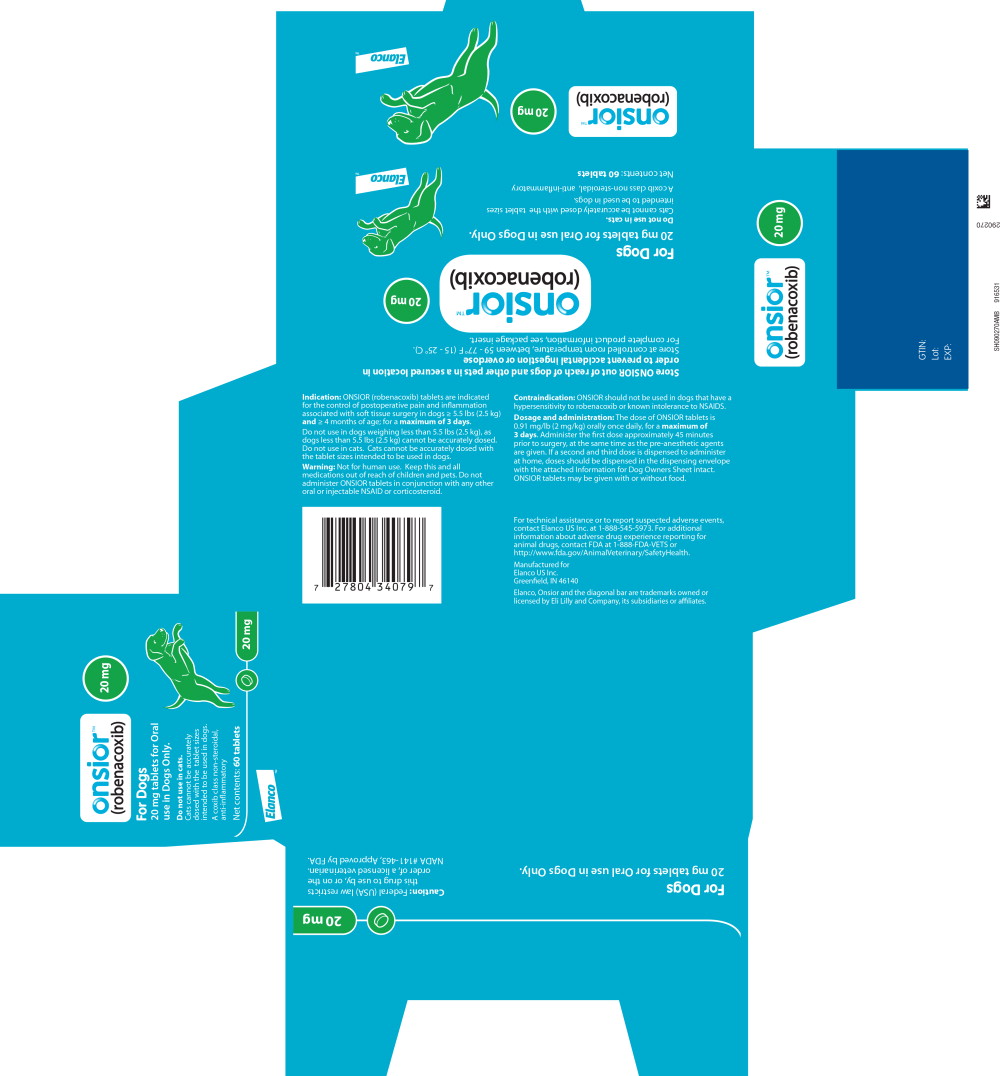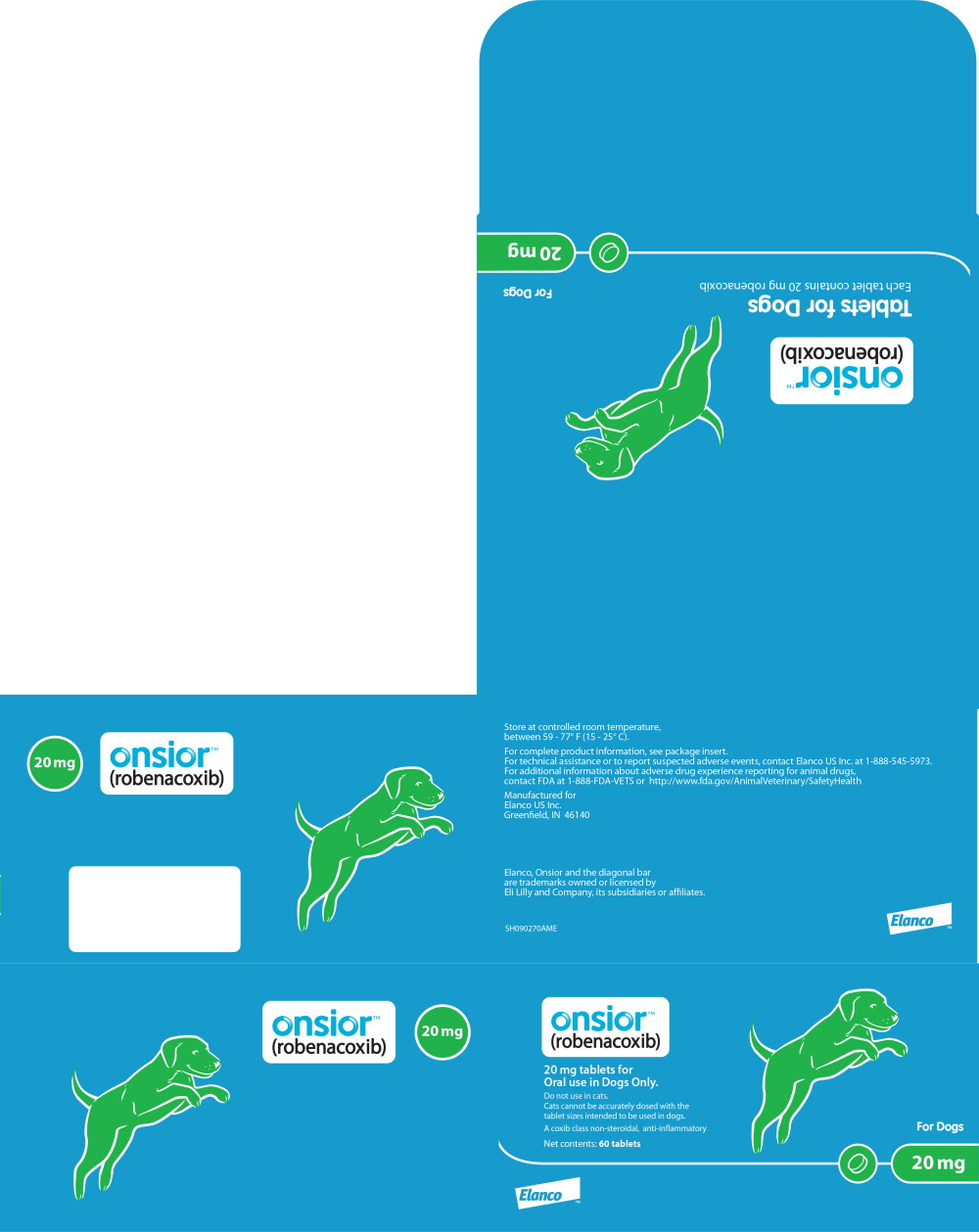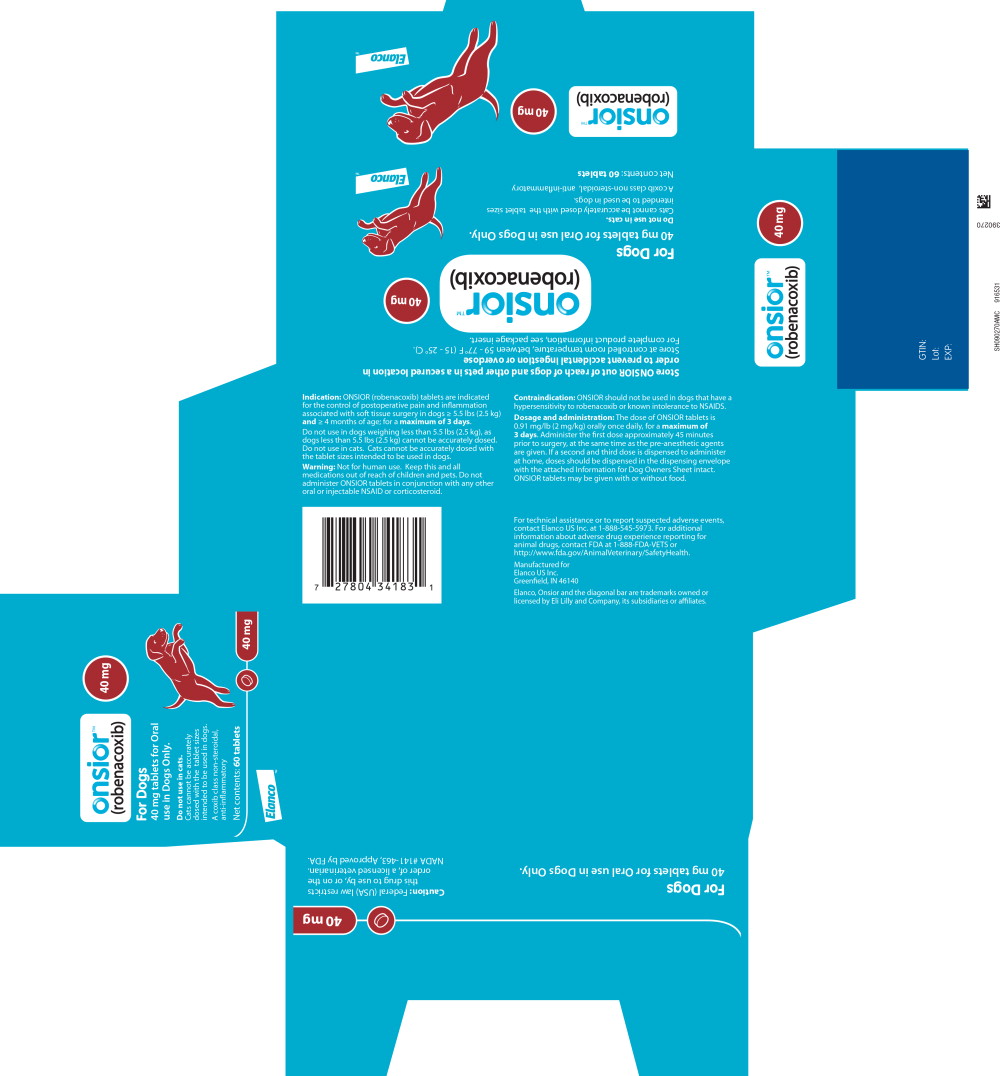ONSIOR- robenacoxib tablet
Onsior by
Drug Labeling and Warnings
Onsior by is a Animal medication manufactured, distributed, or labeled by Elanco US Inc.. Drug facts, warnings, and ingredients follow.
Drug Details [pdf]
- SPL UNCLASSIFIED SECTION
- Caution:
-
Description:
ONSIOR (robenacoxib) is a non-narcotic, non-steroidal anti-inflammatory drug (NSAID) of the coxib class. Tablets are round, beige to brown in color, not scored, flavored and contain robenacoxib. The molecular weight of robenacoxib is 327.28. The empirical formula is C16-H13- F4-NO2. Robenacoxib is [5-Ethyl-2-(2,3,5,6-tetrafluoro-phenylamino)-phenyl]-acetic acid. The structural formula is:
- Indication:
-
Dosage and Administration:
Always provide “Information for Dog Owners” Sheet with prescription. Carefully consider the potential benefits and risk of ONSIOR tablets and other treatment options before deciding to use ONSIOR tablets. Use the lowest effective dose for the shortest duration consistent with individual response.
The dose of ONSIOR tablets is 0.91 mg/lb (2 mg/kg) orally once daily, for a maximum of 3 days. (See Warnings, Precautions and Adverse Reactions).
Dosage Directions: For oral use in dogs ≥ 5.5 lbs and ≥ 4 months of age; for up to a maximum of 3 days. Tablets are not scored and should not be broken. The calculated dosage should be provided using a combination of whole tablet sizes.
Do not use in dogs weighing less than 5.5 lbs (2.5 kg), as dogs less than 5.5 lbs (2.5 kg) cannot be accurately dosed. Do not use in cats. Cats cannot be accurately dosed with the tablet sizes intended to be used in dogs.
The first dose should be administered approximately 45 minutes prior to surgery, at the same time as the pre-anesthetic agents are given.
ONSIOR tablets may be given with or without food.
If a second and third dose is dispensed to the client to administer at home, doses should be dispensed in the dispensing envelope with the attached Information for Dog Owners Sheet intact. Do not remove Information for Dog Owners Sheet.
- Contraindications:
-
Warnings:
Not for use in humans. Keep this and all medications out of reach of children and pets. Consult a physician in case of accidental ingestion by humans. For oral use in dogs only. Store ONSIOR out of reach of dogs and other pets in a secure location in order to prevent accidental ingestion or overdose. Do not use in cats. Cats cannot be accurately dosed with the tablet sizes intended to be used in dogs.
Do not use for more than 3 days. Do not administer ONSIOR tablets in conjunction with any other oral or injectable NSAID or corticosteroid. Serious adverse events have been reported, including hepatopathy, with the long term use (28 day study) of robenacoxib in dogs (See Adverse Reactions). Safety not demonstrated for longer than 3 days.
All dogs should undergo a thorough history and physical examination before the initiation of NSAID therapy. Appropriate laboratory tests should be conducted to establish hematological and serum biochemical baseline data prior to administration of an NSAID. Owners should be advised to observe for signs of potential drug toxicity (see Adverse Reactions and Animal Safety) and be given an “Information for Dog Owners” sheet about ONSIOR tablets.
-
Precautions:
Stop administration of ONSIOR if the dog experiences inappetence, vomiting or lethargy.
The safe use of ONSIOR has not been evaluated in dogs younger than 4 months of age, dogs used for breeding, or in pregnant or lactating dogs. Dogs receiving ONSIOR should weigh at least 5.5 lbs.
As a class, cyclo-oxygenase inhibitory NSAIDs may be associated with gastrointestinal, renal, and hepatic toxicity. Sensitivity to drug-associated adverse events varies with the individual patient. Dogs that have experienced adverse reactions from one NSAID may experience adverse reactions from another NSAID. Patients at greatest risk for adverse events are those that are dehydrated, on concomitant diuretic therapy, or those with existing renal, cardiovascular, and/or hepatic dysfunction. Anesthetic drugs may affect renal perfusion; approach concomitant use of anesthetics and NSAIDs cautiously. Appropriate monitoring procedures (including ECG, blood pressure, and temperature regulation) should be employed during all surgical procedures. The use of parenteral fluids during surgery is recommended to decrease potential renal complications when using NSAIDs perioperatively.
If additional pain medication is needed after a daily dose of ONSIOR, a non-NSAID/non- corticosteroid class of analgesic may be necessary. Concurrent administration of potentially nephrotoxic drugs should be carefully approached and monitored. NSAIDs may inhibit prostaglandins which maintain normal homeostatic function. Such anti-prostaglandin effects may result in clinically significant disease in patients with underlying or pre-existing disease that has not been previously diagnosed. NSAIDs possess the potential to produce gastrointestinal ulcerations and/or gastrointestinal perforations. Do not use ONSIOR concomitantly with other anti-inflammatory drugs, such as NSAIDs or corticosteroids. Consider appropriate washout times when switching from one NSAID to another or when switching from corticosteroid use to NSAID use.
The use of concomitantly protein-bound drugs with ONSIOR has not been studied in dogs. Commonly used protein-bound drugs include cardiac, anticonvulsant, and behavioral medications. The influence of concomitant drugs that may inhibit metabolism of ONSIOR has not been evaluated. Drug compatibility should be monitored in patients requiring adjunctive therapy.
It is unknown whether dogs with a history of hypersensitivity to ß lactam drugs will exhibit hypersensitivity to ONSIOR. Robenacoxib is poorly soluble in water and in acid solutions readily degrades to form γ-lactam. In dogs, lactam is a minor metabolite of robenacoxib. Additionally, lactam is a degradation product that increases over the shelf life of the tablets. Neurologic signs have been associated with the use of ß lactam drugs; it is unknown if the lactam produced by robenacoxib may cause similar neurologic signs (See Animal Safety).
-
Adverse Reactions:
In a controlled field study, a total of 239 male and female dogs representing 35 breeds were included in the field safety analysis. ONSIOR-treated dogs ranged in age from 6 months to 14 years and weighed 5.9 to 121 lbs (2.7 to 55 kgs). The following table shows the number of dogs exhibiting each observation.
*Dogs may have experienced more than one type or occurence of an event during the study.
Adverse reactions in the soft tissue surgery field study
Adverse Reaction*ONSIOR
(robenacoxib) tablets
N = 119Control (vehicle tablets minus robenacoxib)
N = 120Diarrhea 6 3 Vomiting 6 4 Decreased appetite 3 0 Weight loss 1 0 Hypotension 1 0 The most commonly reported adverse reactions were diarrhea, vomiting, and decreased appetite. Changes in the clinical pathology values were not considered clinically significant.
Occurrences of hepatopathy, ataxia, skin lesions/urticaria, and anaphylaxis have been associated with the use of ONSIOR. In a US month-long pilot study, 3 dogs that received ONSIOR developed hepatic toxicity. Two of these dogs were euthanzied and a third dog recovered after prolonged hospitalization and supportive therapy. In foreign market experience, elevated liver enzymes, hepatic necrosis and death have been associated with the long term use of robenacoxib in dogs. Occurrences of liver failure, hepatitis, and cholangiohepatitis have been reported.
For technical assistance or to report suspected adverse drug events, contact Elanco US Inc. at 1-888-545-5973. For additional information about adverse drug experience reporting for animal drugs, contact FDA at 1-888-FDA-VETS or http://www.fda.gov/AnimalVeterinary/SafetyHealth.
-
Information for Dog Owners:
ONSIOR, like other drugs of its class, is not free from adverse reactions. Owners should be advised of the potential for adverse reactions and be informed of the clinical signs associated with drug intolerance. Adverse reactions may include vomiting, diarrhea, decreased appetite, dark or tarry stools, increased water consumption, increased urination, anemia, yellowing of gums, skin or whites of the eye due to jaundice, lethargy, incoordination, seizure, or behavioral changes. Serious adverse reactions associated with this drug class can occur without warning and in some cases result in death (see Warnings and Adverse Reactions). Owners should be advised to discontinue ONSIOR therapy and contact their veterinarian immediately if signs of intolerance are observed. The vast majority of patients with drug related adverse reactions have recovered when the signs are recognized, the drug is withdrawn, and veterinary care, if appropriate, is initiated.
-
Clinical Pharmacology:
Robenacoxib is a non-steroidal anti-inflammatory drug (NSAID) of the coxib class. Repeated subcutaneous administration showed no evidence of robenacoxib bioaccumulation. Although the bioaccumulation of robenacoxib metabolites has not been tested, radiolabeled studies suggest that the various unidentified metabolites are associated with markedly longer elimination half-lives (approximately 22 hrs) as compared to that of the parent molecule. The activity of these metabolites has not been evaluated. The pharmacokinetics of robenacoxib injection does not differ between male and female dogs, and is linear over the range of 0.25-4 mg/kg in dogs. The pharmacokinetics of robenacoxib tablets are linear over the range of 0.5 - 8 mg/kg.
Absorption
After oral administration of robenacoxib flavored tablets at 1 mg/kg without food, mean whole peak blood concentrations are attained rapidly with Tmax values generally occurring within 0.5 to 1 hr following oral administration. The systemic bioavailability of robenacoxib flavored tablets in dogs was 62% with food and 84% without food. Robenacoxib pharmacokinetics is characterized by extensive within and between subject variability, particularly as it pertains to Cmax (as high as 75% coeffcient of variation). With fasted administration, there may be times where the Cmax value is greater than the AUC0-inf value. While this rarely occurs, it is attributable to a very early and high peak with very rapid post-absorption clearance.
Distribution
Robenacoxib has a relatively small volume of distribution (Vss of 174 to 336 mL/kg, average = 240 mL/kg), which is consistent with a drug that is extensively bound to plasma proteins. Based upon in vitro canine plasma samples, robenacoxib is approximately 98% bound to plasma proteins when at concentrations ranging from 200 – 2000 ng/mL. The corresponding canine in vitro whole blood-plasma ratio in artificially spiked blood was 0.44. Robenacoxib persists longer at the site of inflammation than in the blood (Silber et al, 2010). The clinical relevance of this data has not been shown.
Biotransformation
Robenacoxib is extensively metabolized by the liver in dogs. Apart from one γ-lactam metabolite, the identities of other metabolites are not known in dogs. Robenacoxib is excreted predominately via the biliary route in dogs (approximately 65%); therefore, the majority of the absorbed dose (parent drug and metabolite) is eliminated in the feces. The remainder of the administered dose is eliminated in urine, via the kidneys.
Elimination
After intravenous administration to normal healthy dogs, robenacoxib is rapidly cleared from blood (CL of 0.61 to 1.13 L/kg/hr, average = 0.81 L/kg/hr) with an elimination half-life ranging from 0.41 to 1.07 hrs. After subcutaneous administration to normal healthy dogs, the terminal half-life from blood was within 1 – 4 hrs. The mean elimination half-life estimated after oral administration of 1 mg/kg is 0.86 hours (fasted) and 1.15 hours (fed).
-
Animal Safety:
6-Month Oral Margin of Safety Study:
ONSIOR tablets (5, 10, 20, and 40 mg) were administered orally to 6- to 7-month old healthy Beagles (4/sex/group) at 0, 0.5 (2 mg/kg), 1.5 (6 mg/kg), and 2.5 (10 mg/kg) times the maximum exposure dose based on the tablets sizes, once daily for 6 months. The following variables were evaluated: clinical observations, body weights, food and water consumption, veterinary physical examinations (including neurological assessment), ophthalmoscopic examinations, electrocardiographic examinations, fecal observation with flotation analysis, evaluation of coagulation and buccal mucosal bleeding times, hematology, clinical chemistry, urinalysis, gross pathology (including organ weights), and histopathology.
Findings considered treatment-related include: salivation, soft/mucoid/watery feces, elevated buccal mucosal bleeding times in one 1.5X female and one 2.5X male, gastrointestinal tract lesions on gross necropsy (one 1.5X male had cecal lesions described as red foci, and one 2.5X female had minimal, red mucosal discoloration of the duodenum). The gross lesions did not correspond to any histological changes. In addition, decreased mean ovarian weights in 1.5X and 2.5X females as compared to the controls were observed (there were no gross or histological changes in the ovaries of any study animal).
-
Effectiveness:
Effectiveness was demonstrated using ONSIOR tablets in a masked, vehicle controlled, multi-site field study involving client owned dogs. In this study, 239 dogs presenting for soft tissue surgery were randomly administered ONSIOR tablets or vehicle control. Drug was administered approximately 45 minutes prior to surgery along with pre-anesthetic medications and continued once daily for two additional treatments. All dogs received fluids perioperatively. Effectiveness was evaluated in 231 dogs and field safety was evaluated in 239 dogs. A statistically significant difference in the proportion of treatment successes in the ONSIOR tablets treatment group (89/116; 76.72%) compared to the vehicle control group (74/115; 64.35%) was observed. Twenty seven of the 116 dogs in the robenacoxib group and 41 out of 115 control dogs were treatment failures. On the day of surgery, significant improvement in the total pain scores at various post-surgical time points, and overall significant improvement in response to touch and posture/activity were observed. The results of the field study demonstrate that ONSIOR tablets, when administered for a maximum of 3 days, are effective and well-tolerated for the control of postoperative pain associated with soft tissue surgery in dogs.
-
How Supplied:
ONSIOR tablets are available as 10, 20 and 40 mg round flavored tablets in perforated blisters and are supplied in cards containing 6 tablets. Each carton holds 10 blister cards (60 tablets per carton). The appropriate number of tablets per patient is to be dispensed in an ONSIOR dispensing envelope containing an Information for Dog Owners Sheet.
- Storage Conditions:
-
References:
- Silber H.E., Burgener C., Letellier I.M., Peyrou M., Jung M., King J.N., Gruet P. and Giraudel J.M. (2010) Population pharmacokinetic analysis of blood and joint synovial fluid concentrations of robenacoxib from healthy dogs and dogs with osteoarthritis. Pharmaceutical Research, 27: 2633-2645.
NADA # 141-463, Approved by FDA
Elanco, Onsior and the diagonal bar are trademarks owned or licensed by Eli Lilly and Company, it subsidiaries or affliates.
ElancoTM
-
PATIENT PACKAGE INSERT
onsior™
(robenacoxib)10 mg, 20 mg & 40 mg Tablets for Dogs
For Oral Use In Dogs Only
Information for Dog Owners – You should read this information before starting your dog on ONSIOR tablets.
Store ONSIOR out of reach of dogs and other pets in a secured location in order to prevent accidental ingestion or overdose.
What is ONSIOR?
ONSIOR (robenacoxib) tablets are a prescription non-narcotic, non-steroidal anti-inflammatory (NSAID) of the coxib class. ONSIOR (robenacoxib) tablets are for the control of postoperative pain and inflammation associated with soft tissue surgery (e.g. spay, neuter, tumor removal and stomach surgery) in dogs greater than ≥ 5.5 lbs (2.5 kg) and ≥ 4 months of age for a maximum of 3 days. Do not use in dogs less than 5.5 lbs. Do not use in cats. Cats cannot be accurately dosed with the tablet sizes intended to be used in dogs.
Your dog received the first dose of ONSIOR tablets in the hospital prior to surgery. Your dog should not receive more than one dose a day, for a maximum of 3 total doses. Serious side effects have been associated with long term use. Follow the instructions given to you by your veterinarian.
This summary contains important information about ONSIOR tablets but does not take the place of instructions from your veterinarian. Talk to your veterinarian if you do not understand any of this information or if you want to know more about ONSIOR tablets for dogs.
What kind of results can I expect when my dog takes ONSIOR tablets for postoperative pain and inflammation?
ONSIOR tablets may help your dog to recover more comfortably by controlling postoperative pain and inflammation following soft tissue surgery.
- Control of postoperative pain and inflammation may vary from dog to dog.
- Administer ONSIOR tablets according to your veterinarian's directions, for a maximum of 3 days.
- Consult your veterinarian if your dog appears to be uncomfortable.
Which dogs should not take ONSIOR tablets?
Your dog should not be given ONSIOR tablets if s/he:
- Has had an allergic reaction to robenacoxib, the active ingredient in ONSIOR tablets
- Has had an allergic reaction (such as hives, facial swelling, or red or itchy skin) to aspirin or other NSAIDs
- Is less than 5.5 lbs (2.5 kg) and/or less than 4 months of age
- Has a loss of appetite/decreased appetite
- Has bloody feces or vomit
- Is presently taking aspirin, other NSAIDS, or corticosteroids
- Has a pre-existing liver or kidney condition
- Has any condition predisposing to dehydration
ONSIOR Tablets for Dogs should only be given to dogs.
People should not take ONSIOR tablets. Keep ONSIOR tablets and all medication out of reach of children and pets.
Call your physician immediately if you accidently take ONSIOR tablets. Do not use the dog tablets in cats.
Cats cannot be accurately dosed with the dog tablet sizes intended to be used in dogs. Tablets should not be broken.
Tell your veterinarian about:
- Any side effects your dog has previously experienced from ONSIOR tablets or other NSAIDs
- Any digestive upset (vomiting or diarrhea) your dog has had
- Any cardiovascular, kidney or liver disease your dog has had
- Any other medical problems or allergies that your dog has now or has had in the past
- All medications that you are giving your dog or plan to give your dog, including those you can get without prescription and any dietary supplements
- If you plan to breed your dog, or if your dog is pregnant or nursing
Talk to your veterinarian about:
- The surgery performed on your dog
- What test should be done before surgery and prior to administering ONSIOR tablets
- The signs of postoperative pain or inflammation that may occur following surgery
- Normal events that can be expected after your dog undergoes surgery
- How often your dog may need to be examined by your veterinarian
- The risks and benefits of using ONSIOR tablets.
How to give ONSIOR tablets to your dog.
ONSIOR tablets should be given according to your veterinarian's instructions. Your veterinarian will tell you what amount of ONSIOR tablets is right for your dog. ONSIOR tablets should only be given once a day and for no longer than 3 days. ONSIOR tablets should not be broken. ONSIOR tablets should be given by mouth and may be given with or without food.
What are the possible side effects that may occur in my dog during therapy with ONSIOR tablets?
ONSIOR tablets may cause some side effects in individual dogs. These are normally mild, but serious side effects have been reported in dogs taking non-steroidal anti-inflammatory drugs (NSAIDs) including ONSIOR tablets. Serious side effects can result in death. It is important to stop the medication and contact your veterinarian immediately if you think your dog may have a medical problem or side effect while on ONSIOR tablets. To report a possible side effect, contact your veterinarian or call Elanco US Inc. at 1-888-545-5973. For additional information about adverse drug experience reporting for animal drugs, contact FDA at 1-888-FDA-VETS or http://www.fda.gov/AnimalVeterinary/SafetyHealth.
Look for these possible side effects that may indicate that your dog is having a problem:
- Decrease in appetite
- Vomiting
- Change in bowel movements such as diarrhea or change in stool color
- Change in drinking or urination
- Change in behavior, such as depression or restlessness
If you notice any of the above signs in your dog, stop administering ONSIOR tablets and call your veterinarian.
Can ONSIOR tablets be given with other medications?
ONSIOR tablets should not be given with other non-steroidal anti-inflammatory drugs (NSAIDs – e.g. aspirin, carprofen) or corticosteroids (e.g. prednisone).
Always tell your veterinarian about all medications that you have given your dog in the past, and any medications that you are planning to give with ONSIOR tablets.
What can I do in case my dog eats more than the prescribed amount of ONSIOR tablets?
Contact your veterinarian immediately if your dog eats more than the prescribed amount of ONSIOR tablets.
What else should I know about ONSIOR tablets?
This sheet provides a summary of information about ONSIOR tablets for Dogs. If you have any questions or concerns about ONSIOR tablets or postoperative pain and inflammation, talk to your veterinarian.
As with all prescribed medications, ONSIOR tablets should only be given to the dog for which they are prescribed. They should be given to your dog only for the condition for which they were prescribed, at the prescribed dose, as directed by your veterinarian.
NADA 141-463, Approved by FDA
Elanco, Onsior and the diagonal bar are trademarks owned or licensed by Eli Lilly and Company, its subsidiaries or affiliates.
ElancoTM
PA090270AMB
-
Principal Display Panel - Onsior 10 mg Carton Label
Store ONSIOR out of reach of dogs and other pets in a secured location in
order to prevent accidental ingestion or overdoseStore at controlled room temperature, between 59 - 77° F (15 - 25° C).
For complete product information, see package insert.
onsior™
(robenacoxib)
10 mg
For Dogs
10 mg tablets for Oral use in Dogs Only.
Do not use in cats
Cats cannot be accurately dosed with the tablet sizes
intended to be used in dogs.A coxib class non-steroidal, anti-inflammatory
Net Contents: 60 tablets
ElancoTM
- Principal Display Panel - Onsior 10 mg Display Carton Label
-
Principal Display Panel - Onsior 20 mg Carton Label
Store ONSIOR out of reach of dogs and other pets in a secured location in
order to prevent accidental ingestion or overdoseStore at controlled room temperature, between 59 - 77° F (15 - 25° C).
For complete product information, see package insert.
onsior™
(robenacoxib)
20 mg
For Dogs
20 mg tablets for Oral use in Dogs Only.
Do not use in cats.
Cats cannot be accurately dosed with the tablet sizes
intended to be used in dogs.A coxib class non-steroidal, anti-inflammatory
Net contents: 60 tablets
ElancoTM
- Principal Display Panel - Onsior 20 mg Display Carton Label
-
Principal Display Panel - Onsior 40 mg Carton Label
Store ONSIOR out of reach of dogs and other pets in a secured location in
order to prevent accidental ingestion or overdoseStore at controlled room temperature, between 59 - 77° F (15 - 25° C).
For complete product information, see package insert.
onsior™
(robenacoxib)
40 mg
For Dogs
40 mg tablets for Oral use in Dogs Only.
Do not use in cats.
Cats cannot be accurately dosed with the tablet sizes
intended to be used in dogs.A coxib class non-steroidal, anti-inflammatory
Net contents: 60 tablets
ElancoTM
- Principal Display Panel - Onsior 40 mg Display Carton Label
-
INGREDIENTS AND APPEARANCE
ONSIOR
robenacoxib tabletProduct Information Product Type PRESCRIPTION ANIMAL DRUG Item Code (Source) NDC: 58198-4880 Route of Administration ORAL Active Ingredient/Active Moiety Ingredient Name Basis of Strength Strength robenacoxib (UNII: Z588009C7C) (robenacoxib - UNII:Z588009C7C) robenacoxib 10 mg Inactive Ingredients Ingredient Name Strength Yeast, Unspecified (UNII: 3NY3SM6B8U) Microcrystalline Cellulose (UNII: OP1R32D61U) Pork Liver (UNII: 6EC706HI7F) Powdered Cellulose (UNII: SMD1X3XO9M) Povidone (UNII: FZ989GH94E) Crospovidone, Unspecified (UNII: 2S7830E561) Silicon Dioxide (UNII: ETJ7Z6XBU4) Magnesium Stearate (UNII: 70097M6I30) Water (UNII: 059QF0KO0R) Product Characteristics Color brown (brown) Score no score Shape ROUND (ROUND) Size 10mm Flavor Imprint Code BE Contains Packaging # Item Code Package Description Marketing Start Date Marketing End Date 1 NDC: 58198-4880-3 10 in 1 BOX 1 6 in 1 BLISTER PACK Marketing Information Marketing Category Application Number or Monograph Citation Marketing Start Date Marketing End Date NADA NADA141463 03/21/2016 ONSIOR
robenacoxib tabletProduct Information Product Type PRESCRIPTION ANIMAL DRUG Item Code (Source) NDC: 58198-4885 Route of Administration ORAL Active Ingredient/Active Moiety Ingredient Name Basis of Strength Strength robenacoxib (UNII: Z588009C7C) (robenacoxib - UNII:Z588009C7C) robenacoxib 20 mg Inactive Ingredients Ingredient Name Strength Yeast, Unspecified (UNII: 3NY3SM6B8U) Microcrystalline Cellulose (UNII: OP1R32D61U) Pork Liver (UNII: 6EC706HI7F) Powdered Cellulose (UNII: SMD1X3XO9M) Povidone (UNII: FZ989GH94E) Crospovidone, Unspecified (UNII: 2S7830E561) Silicon Dioxide (UNII: ETJ7Z6XBU4) Magnesium Stearate (UNII: 70097M6I30) Water (UNII: 059QF0KO0R) Product Characteristics Color brown (brown) Score no score Shape ROUND (ROUND) Size 20mm Flavor Imprint Code CD Contains Packaging # Item Code Package Description Marketing Start Date Marketing End Date 1 NDC: 58198-4885-3 10 in 1 BOX 1 6 in 1 BLISTER PACK Marketing Information Marketing Category Application Number or Monograph Citation Marketing Start Date Marketing End Date NADA NADA141463 03/21/2016 ONSIOR
robenacoxib tabletProduct Information Product Type PRESCRIPTION ANIMAL DRUG Item Code (Source) NDC: 58198-4890 Route of Administration ORAL Active Ingredient/Active Moiety Ingredient Name Basis of Strength Strength robenacoxib (UNII: Z588009C7C) (robenacoxib - UNII:Z588009C7C) robenacoxib 40 mg Inactive Ingredients Ingredient Name Strength Yeast, Unspecified (UNII: 3NY3SM6B8U) Microcrystalline Cellulose (UNII: OP1R32D61U) Pork Liver (UNII: 6EC706HI7F) Powdered Cellulose (UNII: SMD1X3XO9M) Povidone (UNII: FZ989GH94E) Crospovidone, Unspecified (UNII: 2S7830E561) Silicon Dioxide (UNII: ETJ7Z6XBU4) Magnesium Stearate (UNII: 70097M6I30) Water (UNII: 059QF0KO0R) Product Characteristics Color brown (brown) Score no score Shape ROUND (ROUND) Size 40mm Flavor Imprint Code BCK Contains Packaging # Item Code Package Description Marketing Start Date Marketing End Date 1 NDC: 58198-4890-3 10 in 1 BOX 1 6 in 1 BLISTER PACK Marketing Information Marketing Category Application Number or Monograph Citation Marketing Start Date Marketing End Date NADA NADA141463 03/21/2016 Labeler - Elanco US Inc. (966985624)
Trademark Results [Onsior]
Mark Image Registration | Serial | Company Trademark Application Date |
|---|---|
 ONSIOR 87234459 5214181 Live/Registered |
ELANCO US INC. 2016-11-11 |
 ONSIOR 79024304 3223362 Dead/Cancelled |
Novartis Tiergesundheit AG 2006-04-20 |
© 2025 FDA.report
This site is not affiliated with or endorsed by the FDA.

